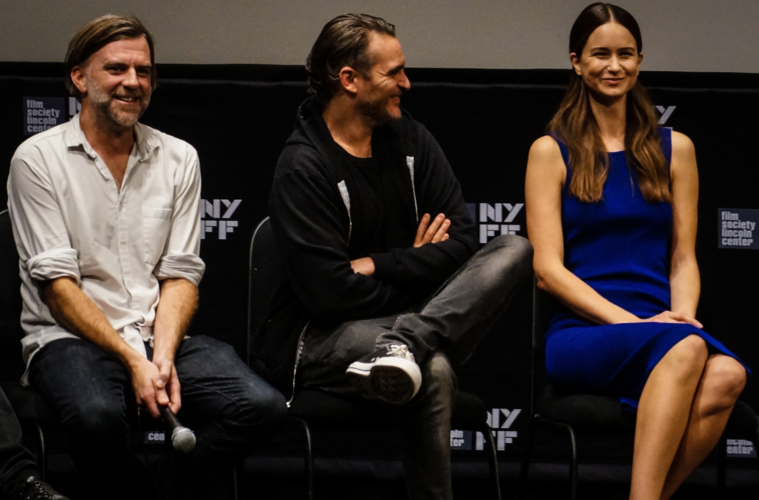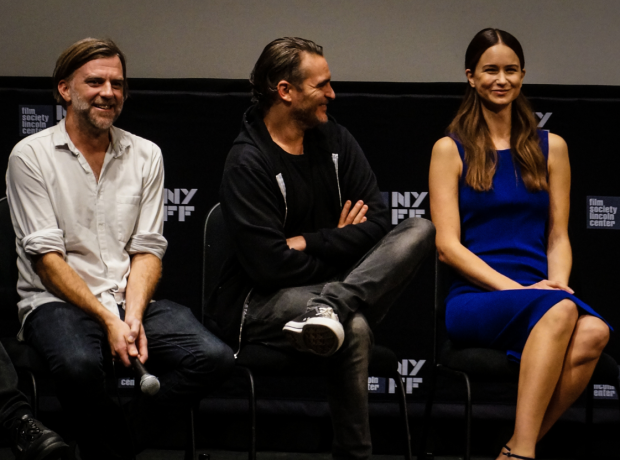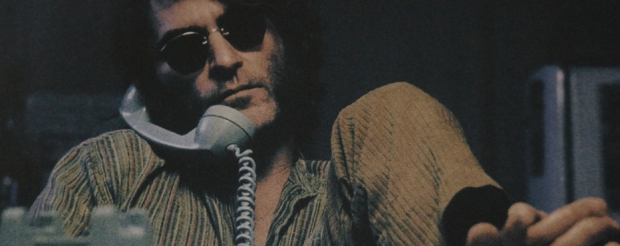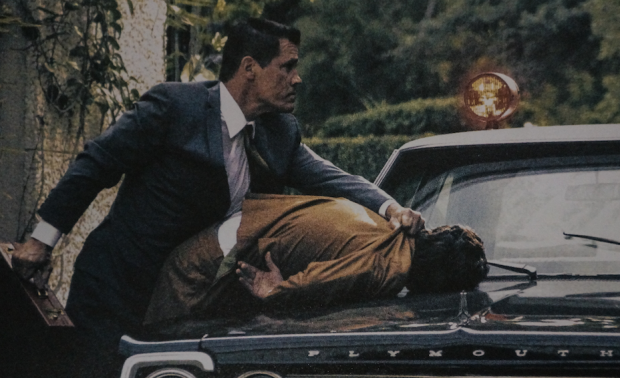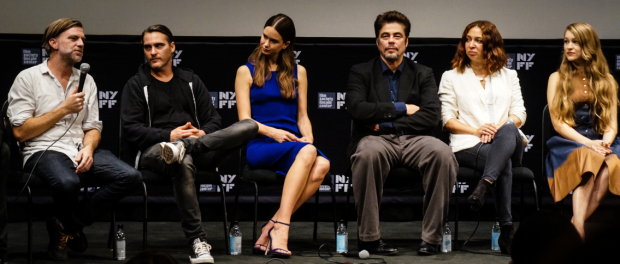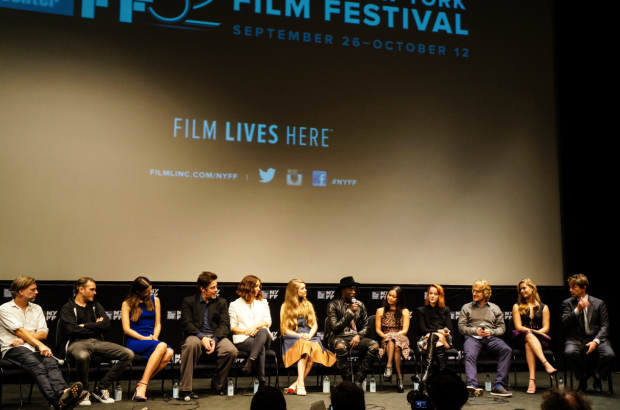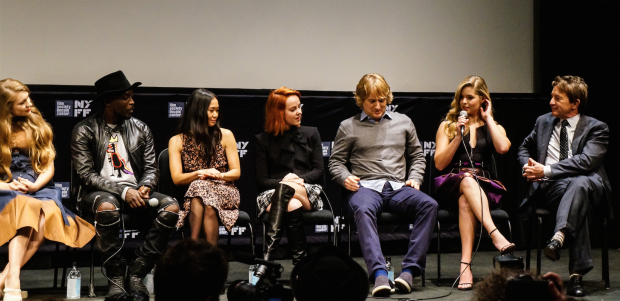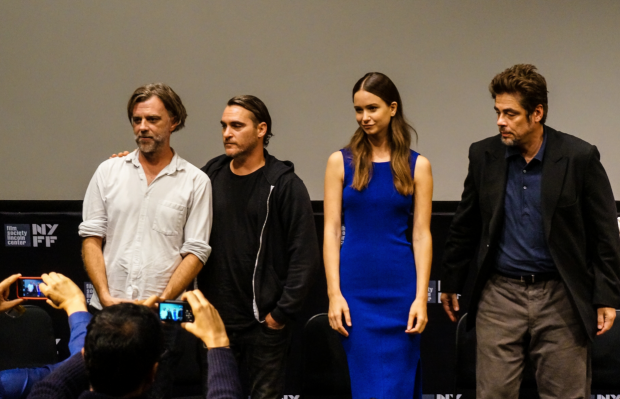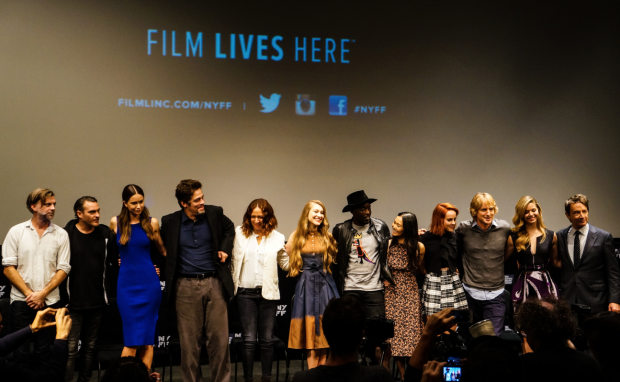“I saw The Big Sleep and it made me realize I couldn’t follow any of it and it didn’t matter because I just wanted to see what happens next anyway,” Paul Thomas Anderson said, describing the “model” he used when it came to Inherent Vice, a keenly faithful adaptation to Thomas Pynchon‘s novel (our review). Indeed, his seventh feature is at once sprawling, with its far-reaching, paranoia-drenched plotting, and intimate, with the majority of scenes featuring prolonged, drug-laced conversations that superbly wrangle every word from Pynchon’s distinct source material.
To some surprise, the novel was only read by a handful of the cast members, eleven of which gathered alongside Anderson for a press conference at New York Film Festival ahead of the premiere. “I had my assistant read it to me. That counts where I’m from,” joked Martin Short, a comedic stand-out in the vast ensemble. When it came to the experience on set, he adds, “If you’re working with a great director you feel very, very, very safe because you know that all decisions and all directions of this film will be made months later in the editing room and so you just feel completely loose.” That looseness was felt by most cast members, including Owen Wilson (who used Dennis Wilson and Zoot from The Muppets as inspiration for his character) and Benicio del Toro, with the latter saying, “I remember jumping in, right into a three-page monologue. I think someone said in order to learn your lines, you need to repeat them 300 times so by the end of the scene, we knew our lines. He would take a scene that takes place on a table and he would move into a car and it was like dancing in a way.”
For others it was more of a mix. “It was really nice, I’ve never been able to collaborate with a director to just sit down with the words and see what feels right — which was a very structured process,” Jena Malone said. “Then getting to sit across the table from Doc and become a wild animal, that’s where the chaos comes from, but that chaos can only come from a grounded, logical base in a way because you have to know where you’re going to be spinning from.” Short added, “It was really trying to create as many elements and colors and hues that could Paul later on when he was putting it together and that’s a freeing up as an actor, particularly if you’re working with someone great.” A newcomer to this sort of environment was an “intimidated” Michael K. Williams, who came with “nervous energy, saying,” It actually makes me feel good to hear you guys say that. I thought it was me. I didn’t think Paul liked me.”
While Anderson countered that with a winking joke, aside from being “stuck” with Joaquin Phoenix — whose private investigator Larry “Doc” Sportello occupies nearly every scene — the large ensemble did lead to some dissatisfaction. He says, “The only frustrating thing, for most people it was only about two or three days, which was a drag because just when you got started you got excited and then they leave on you to go to other movie.”
If Phoenix is the center of the film, then Joanna Newsom‘s Sortilège is the connecting tissue as the narrator, making her feature-film debut. “I loved the way she talked and I loved the way she looked,” Anderson says when it came to her casting and expanded role as narrator. “It was a supporting character in the book, kind of Doc’s best gal pal who always seemed to know more about things and was always right about things. Somewhere along the way [I was] looking to try do something and have a good female voice come in, I came up with the idea of trying to do it and I asked Joanna to do it.”
However, there was some initial hesitation. “For a long time I was told that if you use voice-over, that’s a no no. Someone ingrained that in my mind. I think the premise was that you have to have your characters do work for you. You can’t rely on a narrator to do it. So I kind of got paranoid that you shouldn’t use a narrator,” Anderson added. “But my favorite films use a narrator and narration and I was always paranoid to do it until now, where there was so much good stuff that that character could say that was from the book that seemed helpful to the story and wouldn’t step on it or irritate it or subtract from what was going on, but hopefully add to it as its best and that was the idea there.”
“I had a responsibility to speak the actual text, not only when doing the narration but even on screen I felt sort of yolked by the sense that nothing should come out of my mouth that wasn’t written in the book, or at least written in the script through a decision that was made by the writer,” Newsom adds. “For me it didn’t feel like chaos but sort of receptiveness to change a plan based on a momentary instinct. The first shot of the movie was not on any sides I got. I wasn’t told that was going to happen. I don’t know if that was an improvised decision that Paul made or what, but it was sort of at the end of a day that I had already done my stuff for the day and I was ready to go home and there was a passage that was intended to be voice-over.” The actress said, “I didn’t have it memorized or anything. I just quickly attempted and messed up a couple of times and then finally, hopefully got it sort of right. I didn’t think anything else of it. I was 99% sure it wouldn’t be in the movie and it was.”
That kind of freedom extended to the rest of the cast. “The first day I visited set, before I started shooting, there was a scene between Josh [Brolin] and Joaquin and they were dancing in front of the car,” said Katherine Waterston, who plays the girl-gone-missing, Shasta Fay Hepworth. Paul was standing next to the DP [Robert Elswit], watching him, as the DP was pushing in [her faces becomes exhilarated], so excited to see what they were going to do next. It was so comforting to be going into a working environment in where the director was very interested in what the actors could bring. That’s the feeling that is consistent whether you’re doing something really harebrained and insane or improvisational.”
When one press member described the film as “dour in a good way,” Anderson deflected the notion with a laugh. “Honestly I think what you might be talking about is the book, that’s Thomas Pynchon,” he said. “That’s what he does in his books, is that you have to have — I don’t want to say “literary” because that’s a bad word — but beautifully written and sort of profound and deeply felt stuff mixed in with just the best fart jokes and poop jokes and silly songs and stuff that you could imagine. We were doing an adaptation of the book and we were trying to do that and so that’s where that stuff comes from, trying to be as faithful to the book as possible.”
Regardless of which tone certain scene takes on, this film is visually different than anything the director has done. Much of the dialogue scenes (at least in the first half) feature two shots with slow, calculated push-ins that eventually result in close-ups of whoever Doc has run into next. “There’s a lot of dialogue and there’s two really good actors that can really do it altogether,” Anderson said, giving his reason for the approach. “Any time you can do it without having to cut it together, it’s so much better. Believe it or not, it’s an easier day’s works because you know the one thing you’re going to go after and you go and do it.”
Shot in 1.85:1, something Anderson picked up after The Master — “I thought boxy would be good for this movie. It was really that simple. It felt good for the period,” he says — we were screened the DCP version, which is complete with digitally inserted scratches one would find on a pint. However, for the premiere they did strike a 35mm print. “Luckily we’re still able to keep that alive and keep that going,” Anderson said. “It’s sort of something I started doing at the beginning, so it’s the only way that I know how to do it and I’ve just been able to keep that up and have a great, nice print to show tonight. And all the nerves that accompany that. Everything could break easily and that kind of adds to the thrill of it all and it looks beautiful.” Commenting on the digital vs. film debate, he says, “[I’m] just trying to keep it alive a little bit longer or not try to phase anything out. There’s room for both things. It’s just great that the projectors are still there, it looks beautiful, great. That should just be how it is. Nothing should go away.”
Inherent Vice opens on December 12th.

